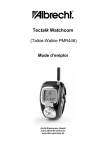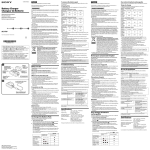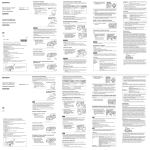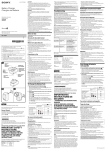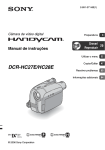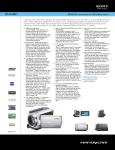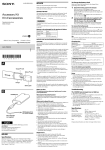Download Sony BC-TRV Operating Instructions
Transcript
4-173-534-11(1) English Thank you for purchasing the Sony Battery charger. Battery Charger Chargeur de Batterie Before operating this Battery charger, please read this manual thoroughly and retain it for future reference. Owner’s Record The model and serial numbers are located on the buttom. Record the serial number in the space provided below. Refer to these numbers whenever you call upon your Sony dealer regarding this product. Model No. BC-TRV Operating Instructions Mode d’emploi Serial No. WARNING To reduce fire or shock hazard, do not expose the unit to rain or moisture. Do not expose the batteries to excessive heat such as sunshine, fire or the like. NOTICE FOR THE CUSTOMERS IN THE U.S.A. AND CANADA IMPORTANT SAFETY INSTRUCTIONS SAVE THESE INSTRUCTIONS. DANGER - TO REDUCE THE RISK OF FIRE OR ELECTRIC SHOCK, CAREFULLY FOLLOW THESE INSTRUCTIONS. BC-TRV For connection to a supply not in the U.S.A., use an attachment plug adapter of the proper configuration for the power outlet, if needed. This power unit is intended to be correctly orientated in a vertical or floor mount position. © 2010 Sony Corporation Printed in Japan Battery to be recharged for this product is follows Brand Name Battery Type NP-FH50 Rating DC 6.8 V (Typical 6.1 Wh Capacity) (900 mAh) Sony NP-FV30 NP-FV50 NP-FV70 NP-FV100 DC 7.2 V DC 6.8 V DC 6.8 V DC 6.8 V 3.6 Wh 7.0 Wh 14.0 Wh 26.5 Wh (500 mAh) (1,030 mAh) (2,060 mAh) (3,900 mAh) CAUTION The BC-TRV battery charger can only be used to charge “InfoLITHIUM” battery packs (V series, H series and P series). “InfoLITHIUM” V series, H series and P series battery packs have the , , and marks, respectively. This unit cannot be used to charge a nickel cadmium type or nickel metal hydride type battery pack. “InfoLITHIUM” is a trademark of Sony Corporation. Le chargeur de batterie BC-TRV ne peut être utilisé que pour charger les batteries « InfoLITHIUM » (série V, série H et série P). Les batteries « InfoLITHIUM » (série V, série H et série P) portent , et . respectivement les marques Cet appareil ne peut pas être utilisé pour charger une batterie rechargeable nickel-cadmium ou nickel-hydrure métallique. « InfoLITHIUM » est une marque commerciale de Sony Corporation. Battery mark Repère de la batterie CHARGE lamp Témoin CHARGE Charging status indicator lamp Témoin d’état de charge Battery pack Batterie rechargeable Charger mark Repère du chargeur Power plug Fiche d’alimentation Connect this unit to an available wall outlet (wall socket). Even when the CHARGE lamp of this unit is off, the power is not disconnected. If any trouble occurs while this unit is in use, unplug it from the wall outlet (wall socket) to disconnect the power. Do not use this unit in a narrow space such as between a wall and furniture. NOTICE FOR THE CUSTOMERS IN THE U.S.A. CAUTION You are cautioned that any changes or modifications not expressly approved in this manual could void your authority to operate this equipment. NOTE This equipment has been tested and found to comply with the limits for a Class B digital device, pursuant to Part 15 of the FCC Rules. These limits are designed to provide reasonable protection against harmful interference in a residential installation. This equipment generates, uses, and can radiate radio frequency energy and, if not installed and used in accordance with the instructions, may cause harmful interference to radio communications. However, there is no guarantee that interference will not occur in a particular installation. If this equipment does cause harmful interference to radio or television reception, which can be determined by turning the equipment off and on, the user is encouraged to try to correct the interference by one or more of the following measures: Reorient or relocate the receiving antenna. Increase the separation between the equipment and receiver. Connect the equipment into an outlet on a circuit different from that to which the receiver is connected. Consult the dealer or an experienced radio/TV technician for help. Notes on Use This unit does not have dust-proof, splash-proof or water-proof specifications. Warranty for Recorded Content Contents of the recording cannot be compensated if recording or playback is not made due to a malfunction of the battery pack, battery charger, etc. Where not to place this unit Do not place this unit in any of the following locations, whether it is in use or in storage. Doing so may lead to a malfunction. In direct sunlight such as on dashboards or near heating apparatus, as this unit may become deformed or malfunction Where there is excessive vibration Where there is strong electromagnetism or radiant rays Where there is excessive sand In locations such as the seashore and other sandy areas or where dust clouds occur, protect this unit from sand and dust. There is a risk of malfunction. Precautions on Use Attach the battery pack firmly to this unit when charging the battery pack. The battery terminal may be damaged if the battery pack is not attached correctly. To protect the battery pack, remove it from this unit when charging is completed. Do not drop or apply mechanical shock to this unit. Keep this unit away from TVs or AM receivers. Noise from this unit may enter a TV or radio if placed nearby. Unplug this unit from the wall outlet (wall socket) after use. Hold this unit when you unplug it from the wall outlet (wall socket). Be sure that nothing metallic comes into contact with the metal parts of this unit. If it does, a short may occur and this unit may be damaged. Do not connect this unit to a voltage adaptor (travel converter) for overseas travel. This may result in overheating or another malfunction. The battery pack and this unit can become warm during or immediately after recharging. You can check the charging status in more detail with the charging status indicator lamp. , ... Off, , ... Lit up Charging status CHARGE lamp indicator lamp Immediately after attaching the battery pack - 30 % 30 % - 60 % 60 % Normal charge Normal charge Full charge After full charge To remove the battery pack Remove the battery pack by sliding it in the opposite direction to when you attached it. Charging time The following table shows the charging time for a battery pack that is completely discharged. “InfoLITHIUM” battery pack V series Battery pack Full charging time Normal charging time NP-FV100 NP-FV70 NP-FV50 680 385 225 (620) (325) (165) “InfoLITHIUM” battery pack H series Battery pack Full charging time Normal charging time NP-FH100 NP-FH70 NP-FH50 680 350 210 (620) (290) (150) “InfoLITHIUM” battery pack P series Battery pack Full charging time Normal charging time NP-FP90 NP-FP71 NP-FP50 525 355 190 (465) (295) Approximate number of minutes to fully charge an empty battery pack (Full charging time). Numbers in parentheses indicate the time to charge normally (Normal charging time). For more about the battery life, see the instruction manual of your video camera. The charging time may differ depending on the condition of the battery pack or the ambient temperature. The times shown are for charging an empty battery pack which has been run down with a video camera, using this unit at an ambient temperature of 25 °C (77 °F). Charging temperature The temperature range for charging is 0 °C to 40 °C (32 °F to 104 °F). For maximum battery efficiency, the recommended temperature range when charging is 10 °C to 30 °C (50 °F to 86 °F). To use the battery pack quickly You can remove the battery pack from this unit and use it even if charging is not completed. However, the charging time affects the time that the battery pack can be used. Notes If the CHARGE lamp does not light up, check if the battery pack is firmly attached to this unit. When a fully charged battery pack is installed, the CHARGE lamp lights up once and then goes out. A battery pack that has not been used for a long time may take longer than usual to charge. Do not connect this unit to a voltage adaptor (travel converter) for overseas travel. This may result in overheating or another malfunction. Troubleshooting When the CHARGE lamp blinks, check through the following chart. When charging a battery pack that has not been used for a long time, the CHARGE lamp may blink in some rare cases. If this happens, remove the battery pack from this unit and then attach and charge it again. The CHARGE lamp blinks in two ways. Blinks slowly: Turns on and off repeatedly every 1.5 seconds Blinks quickly:Turns on and off repeatedly every 0.15 seconds The action to be taken depends on the way the CHARGE lamp blinks. When the CHARGE lamp keeps blinking slowly Charging is pausing. This unit is in the standby state. If the room temperature is out of the appropriate temperature range, charging stops automatically. When the room temperature returns to the appropriate range, the CHARGE lamp lights up and charging restarts. We recommend charging the battery pack at 10 °C to 30 °C (50 °F to 86 °F). When the CHARGE lamp keeps blinking quickly Check through the following chart. Remove the battery pack that is being charged and then firmly attach the same battery pack again. The CHARGE lamp blinks again: Install another battery pack. The CHARGE lamp blinks again: The problem is with this unit. Maintenance If this unit gets dirty, wipe it using a soft dry cloth. If this unit gets very dirty, wipe it using a cloth with a little neutral solvent added, and then wipe it dry. Do not use thinners, benzine, alcohol, etc., as they will damage the surface of this unit. When you use a chemical cleaning cloth, refer to its instruction manual. Using a volatile solvent such as an insecticide or keeping this unit in contact with a rubber or vinyl product for a long time may cause deterioration or damage to this unit. To Charge the Battery Pack The battery pack is charged by attaching it to this unit. * The battery pack illustrated is V series. 1 Attach the battery pack. Align the battery mark in the direction of the charger mark and insert it in the direction of the arrow (See illustration ). 2 Pull the power plug up, and then connect it to a wall outlet (wall socket). Always connect the power plug with the prongs at the top (See illustration ). Do not connect the power plug with the prongs at the bottom (See illustration ). The CHARGE lamp (orange) lights up and charging begins. When the CHARGE lamp goes out, normal charging is completed (Normal charge). For a full charge, which allows you to use the battery pack longer than usual, leave the battery pack in place for approximately another one hour (Full charge). (130) The CHARGE lamp lights up and does not blink again: If the CHARGE lamp goes out because the charging time has passed, there is no problem. The CHARGE lamp lights up and does not blink again: If the CHARGE lamp goes out because the charging time has passed, the problem is with the battery pack first installed. Please contact your nearest Sony dealer in connection with the product that may have a problem. Specifications Input rating Output rating Operating temperature Storage temperature Dimensions Mass Included items 100 V - 240 V AC 50/60 Hz 7 - 12 VA 6 W Battery charge terminal: 8.4 V DC 400 mA 0 °C to 40 °C (32 °F to 104 °F) –20 °C to +60 °C (–4 °F to +140 °F) Approx. 42 × 32 × 79 mm (w/h/d) (1 11/16 × 1 5/16 × 3 1/8 inches) Approx. 61 g (2.2 oz) Battery Charger (BC-TRV) (1) Set of printed documentation Design and specifications are subject to change without notice. Français Merci pour l’achat de ce chargeur de batterie Sony. Avant d’utiliser ce chargeur de batterie, veuillez lire attentivement ce manuel et le conserver pour toute référence future. Aide-mémoire Les numéros de modèle et de série se situent sous l’appareil. Prendre en note le numéro de série dans l’espace prévu ci-dessous. Se reporter à ces numéros lors des communications avec le détaillant Sony au sujet de ce produit. Modèle no BC-TRV No de série AVERTISSEMENT Afin de réduire les risques d’incendie ou de décharge électrique, n’exposez pas cet appareil à la pluie ou à l’humidité. N’exposez pas les piles à une chaleur excessive, notamment aux rayons directs du soleil, à une flamme, etc. AVIS À LA CLIENTÈLE AUX ÉTATS-UNIS ET AU CANADA IMPORTANTES INSTRUCTIONS DE SECURITE - CONSERVEZ CES INSTRUCTIONS DANGER AFIN DE REDUIRE LE RISQUE D’INCENDIE OU DE DECHARGE ELECTRIQUE, SUIVEZ EXACTEMENT CES INSTRUCTIONS Pour le brancher sur une source d’alimentation hors des États-Unis, utilisez l’adaptateur de fiche approprié à la configuration de votre prise électrique, si nécessaire. Cet appareil peut être installé en position verticale ou horizontale. Les batteries pouvant être rechargées pour ce produit sont les suivantes Marque Type de batterie Valeur nominale (Capacité typique) Sony NP-FH50 CC 6,8 V 6,1 Wh (900 mAh) NP-FV30 NP-FV50 NP-FV70 NP-FV100 CC 7,2 V CC 6,8 V CC 6,8 V CC 6,8 V 3,6 Wh 7,0 Wh 14,0 Wh 26,5 Wh (500 mAh) (1 030 mAh) (2 060 mAh) (3 900 mAh) ATTENTION Raccordez cet appareil à une prise murale disponible. Même lorsque le témoin CHARGE de cet appareil est éteint, l’alimentation n’est pas coupée. Si un problème devait se produire pendant l’utilisation de cet appareil, débranchez celui-ci de la prise murale pour le mettre hors tension. N’utilisez pas cet appareil dans un espace confiné, comme entre un mur et un meuble. AVIS À LA CLIENTÈLE AUX ÉTATS-UNIS AVERTISSEMENT Par la présente, vous êtes avisé du fait que tout changement ou toute modification ne faisant pas l’objet d’une autorisation expresse dans le présent manuel pourrait annuler votre droit d’utiliser l’appareil. Note L’appareil a été testé et est conforme aux exigences d’un appareil numérique de Classe B, conformément à la Partie 15 de la réglementation de la FCC. Ces critères sont conçus pour fournir une protection raisonnable contre les interférences nuisibles dans un environnement résidentiel. L’appareil génère, utilise et peut émettre des fréquences radio; s’il n’est pas installé et utilisé conformément aux instructions, il pourrait provoquer des interférences nuisibles aux communications radio. Cependant, il n’est pas possible de garantir que des interférences ne seront pas provoquées dans certaines conditions particulières. Si l’appareil devait provoquer des interférences nuisibles à la réception radio ou à la télévision, ce qui peut être démontré en allumant et éteignant l’appareil, il est recommandé à l’utilisateur d’essayer de corriger cette situation par l’une ou l’autre des mesures suivantes : Réorienter ou déplacer l’antenne réceptrice. Augmenter la distance entre l’appareil et le récepteur. Brancher l’appareil dans une prise ou sur un circuit différent de celui sur lequel le récepteur est branché. Consulter le détaillant ou un technicien expérimenté en radio/ téléviseurs. Remarques concernant l’emploi Cet appareil n’est pas étanche à la poussière, aux éclaboussures d’eau ou à l’eau. Garantie concernant les enregistrements L’utilisateur ne pourra pas être dédommagé pour une absence d’enregistrement ou de lecture due à une défectuosité de la batterie, du chargeur de batterie, ou autre. Où ne pas poser l’appareil Ne posez pas cet appareil aux endroits suivants, ni pour la charge ni pour l’entreposage. Ceci peut entraîner une panne. À la lumière directe du soleil, comme sur le tableau de bord d’une voiture ou à proximité d’un appareil de chauffage, car l’appareil peut se déformer ou tomber en panne. À un endroit exposé à des vibrations excessives À un endroit exposé à un électromagnétisme ou à des radiations À un endroit où il y a beaucoup de sable Au bord de la mer ou sur des sols sableux, où aux endroits où des nuages de poussière sont fréquents, protégez l’appareil du sable ou de la poussière. L’appareil risquerait sinon de tomber en panne. Précautions d’emploi Insérez bien la batterie rechargeable dans cet appareil avant de la charger. La borne de la batterie peut être endommagée si la batterie n’est pas insérée correctement. Pour protéger la batterie rechargeable, retirez-la de cet appareil lorsque la charge est terminée. Ne laissez pas tomber ou n’appliquez pas de choc mécanique à cet appareil. Gardez cet appareil à l’écart des téléviseurs ou récepteurs AM. Placé près d’un téléviseur ou d’un poste de radio, cet appareil peut causer du bruit. Débranchez cet appareil de la prise murale après utilisation. Saisissez cet appareil lorsque vous le débranchez de la prise murale. Veillez à ne pas mettre d’objets métalliques au contact des pièces métalliques de cet appareil. Ceci pourrait causer un court-circuit et endommager l’appareil. Ne branchez pas cet appareil sur un adaptateur de tension (convertisseur de voyage) lorsque vous voyagez à l’étranger. Ceci pourrait causer une surchauffe ou une autre défaillance. La batterie rechargeable et cet appareil peuvent devenir chauds pendant ou immédiatement après la charge. Entretien Lorsque cet appareil est sale, essuyez-le avec un chiffon sec et doux. Lorsque cet appareil est très sale, essuyez-le avec un chiffon et un peu de solvant neutre puis séchez-le. N’utilisez pas de diluants, benzine, alcool, etc. car ils endommageraient la surface de cet appareil. Si vous utilisez un tissu de nettoyage chimique, consultez son mode d’emploi. L’emploi d’un solvant volatil, comme un insecticide, ou la mise en contact direct de cet appareil avec un produit en caoutchouc ou en plastique pendant une longue période peut détériorer ou endommager cet appareil. (Suite à la page arrière) Ne branchez pas cet appareil sur un adaptateur de tension (convertisseur de voyage) lorsque vous voyagez à l’étranger. Ceci pourrait causer une surchauffe ou une autre défaillance. ˎ ˎ ˎ ˎ En cas de problème Lorsque le témoin CHARGE clignote, vérifiez les points du tableau suivant. Pendant la charge d’une batterie inutilisée pendant un certain temps, le témoin CHARGE peut clignoter dans certains cas toutefois assez rares. Dans ce cas, retirez la batterie de cet appareil puis installez-la et chargezla de nouveau. è Le témoin CHARGE clignote de deux façons. Clignotement lent : S’allume et s’éteint toutes les 1,5 secondes de façon répétée. Clignotement rapide : S’allume et s’éteint toutes les 0,15 secondes de façon répétée. La mesure à prendre dépend de la façon dont le témoin CHARGE clignote. è ˎ ˎ Lorsque le témoin CHARGE continue de clignoter lentement La charge est en pause. Cet appareil est en attente. Si la température de la pièce est hors de la plage de températures appropriée, la charge s’arrête automatiquement. Lorsque la température de la pièce revient dans la plage appropriée, le témoin CHARGE s’allume et la charge redémarre. Il est conseillé de charger la batterie rechargeable entre 10 °C et 30 °C (50 °F et 86 °F ). è Lorsque le témoin CHARGE continue de clignoter rapidement Vérifiez les points du tableau suivant. Retirez la batterie rechargeable qui a été chargée et insérez-la de nouveau fermement dans le chargeur. Français (Suite de la page avant) Pour charger la batterie rechargeable La batterie rechargeable se charge lorsqu’elle est insérée dans cet appareil. * La batterie illustrée est une batterie de série V. 1 Insérez la batterie rechargeable. Alignez le repère de la batterie dans la direction du repère du chargeur et insérez la batterie dans le sens de la flèche (Voir l’illustration ). 2 Relevez la fiche d’alimentation, puis branchez-la sur une prise murale. Raccordez toujours la fiche d’alimentation avec les broches orientées vers le haut (Voir l’illustration ). Ne raccordez pas la fiche d’alimentation avec les broches orientées vers le bas (Voir l’illustration ). Le témoin CHARGE (orange) s’allume et la recharge commence. Lorsque le témoin CHARGE s’éteint, la charge normale est terminée (Charge normale). Pour une charge complète, qui permet d’utiliser la batterie rechargeable plus longtemps que la normale, laissez la batterie rechargeable en place pendant encore une heure environ (Charge complète). Vous pouvez avoir un aperçu plus exact de l’état de charge grâce au témoin de charge. , ... Éteint, , ... Éclairé Témoin d’état de Témoin CHARGE charge Immédiatement après l’installation de la batterie - 30% 30 % - 60 % 60 % Charge normale Charge normale Charge complète Après une charge complète Le témoin CHARGE clignote de nouveau : Installez une autre batterie. Le témoin CHARGE s’allume et ne clignote plus : Si le témoin CHARGE s’éteint parce que le temps de charge est dépassé, il n'y a aucun problème. Le témoin CHARGE clignote de nouveau : Le problème vient de cet appareil. Le témoin CHARGE s’allume et ne clignote plus : Si le témoin CHARGE s’éteint parce que le temps de charge est dépassé, le problème vient de la première batterie installée. Veuillez contacter le revendeur Sony le plus proche du produit présentant éventuellement un problème. ˎ ˎ ˎ ˎ ˎ ˎ ˎ ˎ ˎ ˎ ˎ ˎ Spécifications Puissance nominale d’entrée Puissance nominale de sortie Température de fonctionnement Température d’entreposage Dimensions Poids Articles inclus ˎ 100 V - 240 V CA 50/60 Hz 7 - 12 VA 6 W Borne de charge de la batterie : 8,4 V CC 400 mA 0 °C à 40 °C (32 °F à 104 °F) –20 °C à +60 °C (–4 °F à +140 °F) environ 42 × 32 × 79 mm (l/h/p) (1 11/16 × 1 5/16 × 3 1/8 pouces) environ 61 g (2,2 oz) Chargeur de batterie (BC-TRV) (1) Jeu de documents imprimés ˎ ˎ ˎ ˎ ˎ La conception et les spécifications peuvent être modifiées sans préavis. 1 2 Ć Ć í Temps de charge í Le tableau suivant montre le temps de charge pour une batterie rechargeable complètement déchargée. Batterie « InfoLITHIUM » série V NP-FV70 NP-FV50 680 385 225 (620) (325) (165) Batterie « InfoLITHIUM » série H Batterie rechargeable Temps de charge complète Temps de charge normale NP-FH100 NP-FH70 NP-FH50 680 350 210 (620) (290) (150) Batterie « InfoLITHIUM » série P Batterie rechargeable Temps de charge complète Temps de charge normale NP-FP90 NP-FP71 NP-FP50 525 355 190 (465) (295) (130) Nombre approximatif de minutes pour charger complètement une batterie rechargeable vide (Temps de charge complète). Les nombres entre parenthèses indiquent le temps pour une charge normale (Temps de charge normale). Pour de plus amples informations sur l’autonomie de la batterie, reportez-vous au mode d’emploi de votre caméscope. Le temps de charge peut être différent selon l’état de la batterie rechargeable ou la température ambiante. Les temps indiqués correspondent à la charge d’une batterie rechargeable vide, usée sur un caméscope, avec cet appareil à une température ambiante de 25 °C (77 °F). ˎ ˎ ˎ ˎ ˎ Température de charge La température doit se situer entre 0 °C et 40 °C (32 °F à 104 °F) pour la charge. Pour une efficacité maximale de la batterie, la température conseillée pour la charge est de 10 °C à 30 °C (50 °F à 86 °F). Pour utiliser rapidement la batterie rechargeable Vous pouvez retirer la batterie rechargeable de cet appareil et l’utiliser même si la charge n’est pas terminée. Cependant, le temps de charge a une influence sur l’autonomie de la batterie rechargeable. Remarques Si le témoin CHARGE ne s’allume pas, vérifiez si la batterie rechargeable est bien insérée dans cet appareil. Lorsqu’une batterie chargée est installée, le témoin CHARGE s’allume une fois puis s’éteint. Une batterie rechargeable qui n’a pas été utilisée pendant longtemps peut être plus longue à charger que la normale. Ć Ć Retirez la batterie en la faisant glisser dans le sens opposé de l’insertion. NP-FV100 ȏ Ȑ í Pour retirer la batterie rechargeable Batterie rechargeable Temps de charge complète Temps de charge normale èè Ȏ ˎ ˎ ˎ
This document in other languages
- français: Sony BC-TRV




